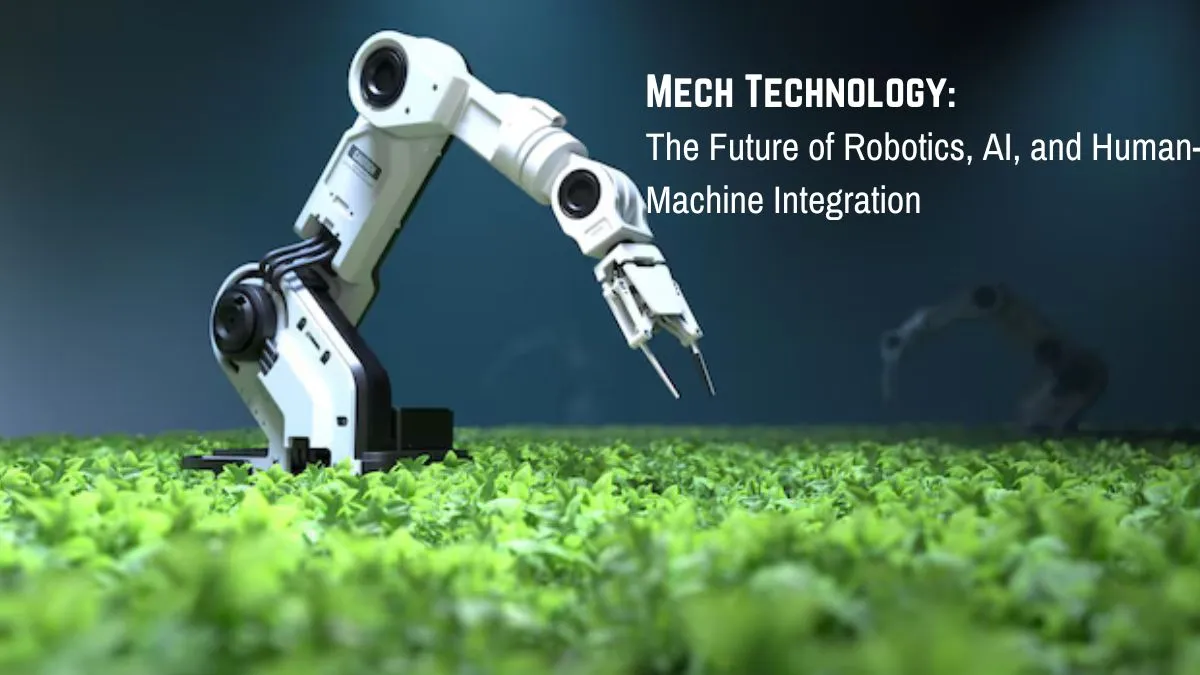TECHNOLOGY
Mech Technology: The Future of Robotics, AI, and Human-Machine Integration

Mech technology is no longer just science fiction. It’s real, evolving, and shaping industries worldwide. These advanced robotic systems, powered by AI and cutting-edge engineering, are designed for combat, construction, healthcare, and even space exploration.Now, imagine similar mechs in real life, assisting soldiers or workers in extreme conditions. That’s the future we’re heading toward. The demand for automation and efficiency is pushing mech technology forward at an unprecedented pace. But is the world ready? With increasing investments and research, the age of human-machine collaboration is closer than ever. This article explores how mech technology is revolutionizing industries and changing the way humans interact with machines.
The Science Behind Mech Technology
How does a mech move? How does it respond to the environment? The key is in a combination of artificial intelligence, hydraulics, and high-tech materials. These machines are not massive, lumbering robots. They’re engineered with lightweight alloys, carbon fiber, and intelligent materials to improve agility and resilience. AI-driven sensors sense movement, adapt to terrain, and even anticipate mechanical breakdowns before they occur. Energy sources? That’s a challenge. Though batteries and fuel cells energize the majority of mechs today, researchers are investigating wireless energy transfer. A never-ending source of power for a mech sounds like a science fiction book, doesn’t it? But with continuous improvements, mech technology continues to get more efficient, dependable, and independent.
Types of Mech Technology
Mechs are varied in shape and size. Humanoid mechs are human-like and help with medical or industrial work. There are also giant vehicle mechs for construction and the military. Autonomous mechs? They don’t require human drivers—they operate on AI programs. Wearable mechs, such as exoskeletons, augment human strength and stamina. Each is used for a specific purpose, revolutionizing industries in various ways. Think of a firefighter equipped with an exoskeleton, lifting debris effortlessly. Or an autonomous mech exploring hazardous environments. The possibilities are endless. As mech technology evolves, we’ll see more specialized robots designed to meet industry-specific needs, making tasks safer, faster, and more efficient.
AI and Machine Learning in Mechs
AI is the mind of mech technology. Without it, they are mere lifeless metal. With AI, they learn, evolve, and even make choices. Machine learning algorithms assist mechs in processing data, identifying patterns, and improving performance. Ever watched a self-driving car steer around an obstacle? That’s AI at work. Now imagine a military mech steering clear of enemy fire with similar technology. Neural networks allow these robots to anticipate movements, evaluate environments, and react in real time. But there’s a caveat—AI is not flawless. It requires training, enormous data sets, and ongoing updates. Nevertheless, the more AI is incorporated into mech technology, the nearer we come to having fully autonomous, smart machines that function in harmony with humans.
Mech Technology in the Military
Warfare is evolving. Tanks and airplanes are still powerful, but mech technology is on the march onto the battlefield. Nations are developing robotic soldiers, exoskeleton armor, and AI-powered combat units. The benefit? Mechs don’t tire. They don’t experience fear. They carry out missions with accuracy. Picture a battlefield with mechs hauling heavy artillery, transporting wounded soldiers, and delivering real-time intelligence. Sounds like science fiction, but it is on its way. The U.S., China, and Russia already have military mechs being tested. But is it ethical to give robots the ability to make life-or-death decisions? That’s an argument still being made. This much is certain: mech technology is transforming contemporary warfare, for good or ill.
Industrial and Commercial Applications of Mech Technology
Mecha suits aren’t just for combat. Industries are employing them to enhance productivity and mitigate risks. In building construction, mech suits assist workers in lifting heavy loads effortlessly. Factories employ robotic arms for precision work. Logistics companies utilize mech-powered automation for speedy delivery. Ever walked past a warehouse packed with self-propelled robots sorting packages? That’s mecha technology in action. The objective is straightforward—make work easier, safer, and more efficient. There’s a catch. Automation puts jobs at risk. With evolving mech tech, industries will have to find a balance between efficiency and sustainable workforce. But the positives outweigh the negatives. Mechs are not going away anytime soon, shaping workspaces globally.
Medical and Rehabilitation Mechs
Picture being paralyzed and then walking again. That’s the potential of mech technology in medicine. Exoskeletons are restoring mobility to people with disabilities. Robotic prosthetics provide near-human dexterity. Mech-powered assistive devices are used in hospitals for patient care. It’s life-altering technology, literally. Stroke survivors, spinal injury patients, and amputees gain significantly from these technologies. But access is a problem. High prices keep these life-improving mechs out of the reach of many. Developments are dedicated to rendering them accessible, efficient, and flexible. The health sector is still discovering the ways in which mech tech can make life better, confirming that robotics is not merely about automation but about empowerment.
Mech Technology in Space Exploration
Mars rovers. Lunar robots. Space mechs. These machines explore where humans can’t. NASA and private companies are investing in mech technology for deep-space missions. Imagine a humanoid robot building structures on Mars or repairing satellites in orbit. It’s not just theory—it’s happening. Space mechs are designed to withstand extreme temperatures, radiation, and zero gravity. They perform complex tasks without human risk. The challenge? Developing durable, self-sustaining mechs that can survive years in space. But with companies like SpaceX and Blue Origin pushing innovation, the dream of autonomous space exploration is inching closer to reality.

The Role of Mech Technology in Everyday Life
Think mech technology is only for the military or industries? Think again. Everyday gadgets are becoming more mech-like. Smart home assistants, robotic vacuum cleaners, and AI-driven security bots are common now. Wearable mech suits could soon help elderly people with mobility. Law enforcement is testing mech-powered exoskeletons for enhanced strength and endurance. Even sports industries are experimenting with mech tech for performance training. The future? Personal mechs assisting with daily tasks—carrying groceries, cooking, cleaning. It’s closer than you think. As technology advances, mech-assisted living will become the norm, seamlessly integrating into our lives.
Challenges and Limitations of Mech Technology
Mech technology isn’t perfect. High costs make it inaccessible for many industries. Battery life is a major limitation—most mechs can’t operate for long without recharging. AI, while advanced, still makes mistakes. There’s also a growing concern about job losses as automation takes over. And let’s not forget ethics. Should autonomous mechs be given decision-making power? Can they be hacked? These concerns slow down development. Despite these hurdles, research continues. Companies and scientists are working to make mech technology more reliable, ethical, and affordable. The goal? A future where mechs enhance human life without disrupting society.
The Future of Mech Technology
What’s next? Imagine mechs controlled directly by human thought. Brain-machine interfaces are already in development. AI-driven mechs will become more intuitive, capable of complex interactions. Military mechs will replace soldiers in dangerous missions. Industrial robots will operate with near-human precision. Space mechs will build extraterrestrial colonies. It’s not a question of “if” but “when.” Mech technology is evolving rapidly, changing how we work, fight, explore, and live. The future is closer than we think, and it’s built on steel, circuits, and artificial intelligence.
Conclusion
Mech technology is no longer a distant dream. It’s here, growing, and reshaping our world. From warfare to healthcare, space to daily life, its impact is undeniable. But challenges remain—cost, ethics, and reliability. The key lies in responsible innovation. As mech technology continues to evolve, society must adapt, ensuring these powerful machines serve humanity rather than replace it. One thing’s certain: the future of human-machine integration is just beginning, and it’s more exciting than ever.
-

 BIOGRAPHY6 months ago
BIOGRAPHY6 months agoBehind the Scenes with Sandra Orlow: An Exclusive Interview
-

 HOME1 year ago
HOME1 year agoDiscovering Insights: A Deep Dive into the //vital-mag.net blog
-

 HOME1 year ago
HOME1 year agoSifangds in Action: Real-Life Applications and Success Stories
-

 BIOGRAPHY1 year ago
BIOGRAPHY1 year agoThe Woman Behind the Comedian: Meet Andrew Santino Wife




























